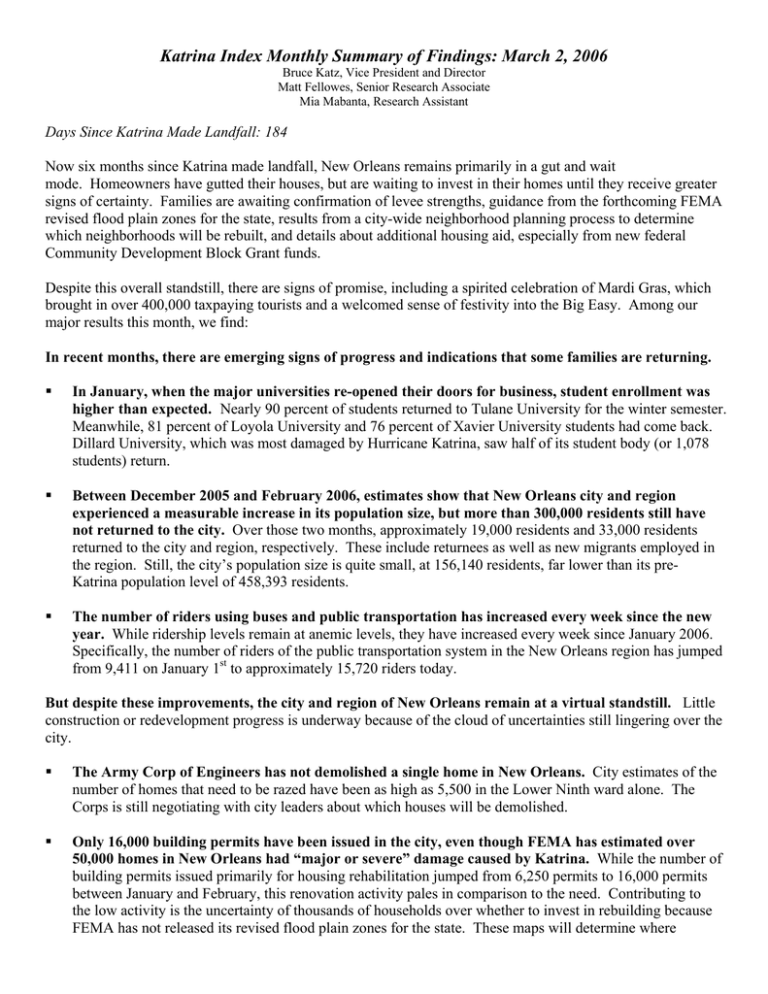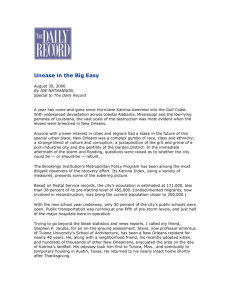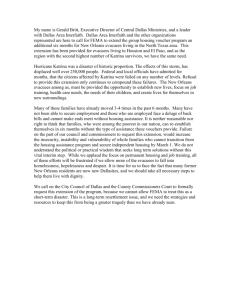Katrina Index Monthly Summary of Findings: March 2, 2006
advertisement

Katrina Index Monthly Summary of Findings: March 2, 2006 Bruce Katz, Vice President and Director Matt Fellowes, Senior Research Associate Mia Mabanta, Research Assistant Days Since Katrina Made Landfall: 184 Now six months since Katrina made landfall, New Orleans remains primarily in a gut and wait mode. Homeowners have gutted their houses, but are waiting to invest in their homes until they receive greater signs of certainty. Families are awaiting confirmation of levee strengths, guidance from the forthcoming FEMA revised flood plain zones for the state, results from a city-wide neighborhood planning process to determine which neighborhoods will be rebuilt, and details about additional housing aid, especially from new federal Community Development Block Grant funds. Despite this overall standstill, there are signs of promise, including a spirited celebration of Mardi Gras, which brought in over 400,000 taxpaying tourists and a welcomed sense of festivity into the Big Easy. Among our major results this month, we find: In recent months, there are emerging signs of progress and indications that some families are returning. In January, when the major universities re-opened their doors for business, student enrollment was higher than expected. Nearly 90 percent of students returned to Tulane University for the winter semester. Meanwhile, 81 percent of Loyola University and 76 percent of Xavier University students had come back. Dillard University, which was most damaged by Hurricane Katrina, saw half of its student body (or 1,078 students) return. Between December 2005 and February 2006, estimates show that New Orleans city and region experienced a measurable increase in its population size, but more than 300,000 residents still have not returned to the city. Over those two months, approximately 19,000 residents and 33,000 residents returned to the city and region, respectively. These include returnees as well as new migrants employed in the region. Still, the city’s population size is quite small, at 156,140 residents, far lower than its preKatrina population level of 458,393 residents. The number of riders using buses and public transportation has increased every week since the new year. While ridership levels remain at anemic levels, they have increased every week since January 2006. Specifically, the number of riders of the public transportation system in the New Orleans region has jumped from 9,411 on January 1st to approximately 15,720 riders today. But despite these improvements, the city and region of New Orleans remain at a virtual standstill. Little construction or redevelopment progress is underway because of the cloud of uncertainties still lingering over the city. The Army Corp of Engineers has not demolished a single home in New Orleans. City estimates of the number of homes that need to be razed have been as high as 5,500 in the Lower Ninth ward alone. The Corps is still negotiating with city leaders about which houses will be demolished. Only 16,000 building permits have been issued in the city, even though FEMA has estimated over 50,000 homes in New Orleans had “major or severe” damage caused by Katrina. While the number of building permits issued primarily for housing rehabilitation jumped from 6,250 permits to 16,000 permits between January and February, this renovation activity pales in comparison to the need. Contributing to the low activity is the uncertainty of thousands of households over whether to invest in rebuilding because FEMA has not released its revised flood plain zones for the state. These maps will determine where insurance and loans will be made available, the building specifications and elevations owners will need to adopt, and provide more certainty about the rebuilding prospects of neighborhoods through out the city. Median home prices in the New Orleans metro area have increased in the last three quarters of 2005, rising to a median home price of $181,000, a sign of increased demand, limited housing supply, but a cautious sign of rising housing costs. Many families are purchasing new homes in areas of higher ground as they wait to rebuild their former homes. This unique housing market, in a sea of limited supply, is pushing home prices and likely rental prices up in the region. This raises real concerns about whether entry-level workers and other working families can find affordable housing if and when they wish to return to the city. FEMA has allocated over $5.3 billion for trailers and mobile homes that currently house just 83,000 of the nearly 800,000 households still displaced by Katrina. There are currently 1,276 evacuated households living in cruise ships, 10,266 living in hotels, 83,500 in trailer or mobile homes, and 700,000 receiving rental assistance. To date, FEMA has allocated $236 million for cruise ships, at least $529 million for hotels, $5.3 billion for trailers and mobile homes, and about $3.1 billion for rental assistance and home repair assistance. Going forward, New Orleans is poised to make substantial progress. Billions of dollars of federal Community Development Block Grants will flow into the city and its surrounding parishes, facilitating the rehabilitation of homes and strengthening essential services and infrastructure. With federal funding now secured to begin the rebuilding process, it is incumbent upon federal, state, and local leaders to work together to put forth a unified plan for rebuilding the city and southern Louisiana and to market their implementation plans to families, no matter where across the country they live. It is also critical for federal, state and local leaders to release the FEMA flood maps soon and erase other areas of uncertainty so that families can make quick and informed decisions about their future. Extending the wait is an increasingly fruitless option.







